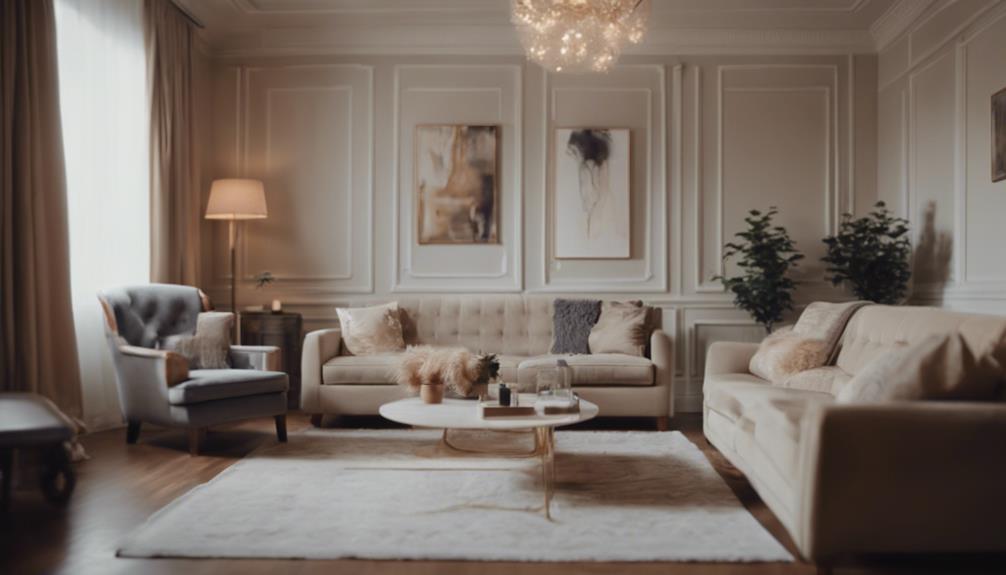Understanding scale and proportion in interior decorating is crucial for achieving a well-balanced and visually pleasing space. Scale refers to properly fitting furniture in a room to avoid overcrowding or sparse arrangements. Proportion, on the other hand, impacts the overall aesthetic appeal and helps create harmony in the design. Balancing furniture sizes, utilizing room dimensions effectively, and carefully considering artwork placement all contribute to achieving a harmonious visual effect. To improve the functionality and flow of a room, it is important to select and arrange items thoughtfully to maintain visual harmony. By mastering scale and proportion, you can create a space that feels cohesive and welcoming.
Key Takeaways
- Scale ensures furniture fits harmoniously in a space.
- Proportion creates visual balance and unity in rooms.
- Balancing furniture sizes prevents overpowering or cramped feel.
- Strategic placement enhances room openness and functionality.
- Properly scaled artwork and decor elements enhance room design.
Importance of Scale in Decorating

Maintaining proper scale in decorating is fundamental for harmoniously fitting furniture and objects within a space, enhancing both functionality and visual appeal. Scale in interior design refers to the size of items in relation to the space they occupy.
When scale is off, a room can feel overwhelmed by large furniture or sparse due to tiny pieces. It's important to carefully consider scale when selecting items for a room to achieve a balanced look. By paying attention to scale, we can create a sense of proportion and balance, contributing to a well-designed space.
When everything is in the right scale, the room feels cohesive and inviting. Proper scale ensures that furniture and decor complement each other, avoiding a cluttered or mismatched appearance. Essentially, scale plays a significant role in interior design, influencing how we perceive and interact with the spaces we inhabit.
Achieving Visual Harmony Through Proportion

Moving from discussing the Importance of Scale in Decorating to our current focus on Achieving Visual Harmony Through Proportion, we shift our attention to how proportion influences the overall aesthetic appeal of interior spaces.
Proportion in interior design plays an essential role in creating a sense of balance and unity within a room. When furniture and accessories are proportionate to the space they occupy, visual harmony is achieved. This harmony allows for a smooth flow and enhances the functionality of the room.
Balancing Furniture Sizes in Rooms

Balancing furniture sizes in rooms involves maintaining a harmonious arrangement where large pieces don't overpower the space. It's important to take into account the proportion and scale of furniture when furnishing a room, especially in small spaces. Ensuring that furniture sizes are proportionate to the room's dimensions creates a visually appealing layout. Mixing different furniture sizes can add interest and prevent a monotonous look in the space.
In smaller rooms, selecting appropriately scaled furniture is vital to avoid a cramped feel. Oversized furniture can disrupt the balance and scale of a room, negatively impacting its overall aesthetic. By carefully choosing furniture sizes that complement the room's dimensions, you can create a sense of harmony and balance. Remember that the goal is to create a space that feels comfortable and visually pleasing, so paying attention to furniture proportions is key in achieving this.
Creating a Sense of Space With Scale

When aiming to create a sense of space with scale in interior decorating, consider strategic furniture placement tricks and the use of large artwork.
Placing furniture in a way that optimizes the room's proportions can enhance the feeling of openness and airiness.
Incorporating oversized art pieces can draw the eye upward, making the room appear larger and more expansive.
Furniture Placement Tricks
Strategically placing furniture away from walls and creating pathways around them can effectively enhance the sense of space in a small room while maintaining proper scale. By optimizing furniture placement, you can guarantee that the room doesn't feel cramped.
Choosing pieces that fit the scale and proportion of the room is essential for creating a harmonious look. To add visual interest, consider using multifunctional furniture like ottomans or nesting tables that can maximize space efficiently. Opting for furniture with exposed legs can also contribute to a sense of openness and lightness, making the room feel more spacious.
Additionally, utilizing mirrors strategically to reflect light can create the illusion of more space, enhancing the overall scale. Remember, thoughtful furniture placement can transform a small room into a comfortable and visually appealing space.
Using Large Artwork
Utilizing large artwork in interior decorating can visually expand a room and evoke a sense of grandeur and spaciousness. In small rooms, strategically placing oversized art pieces can create the illusion of a larger, more open space.
The importance of the artwork scale is vital; it should complement the size of the wall and the room to guarantee a harmonious look. Large artwork can serve as a focal point, adding drama and drawing attention to a specific area. By selecting the right pieces and placing them thoughtfully, you can greatly impact the overall design aesthetic and mood of the room.
Enhancing Room Balance With Proportion

To enhance room balance with proportion, we carefully consider the sizing and placement of furniture and decor elements. By ensuring that design elements are in proportion to each other, we can achieve a harmonious and visually pleasing space. Proper proportion plays an important role in creating balance and visual unity within a room's design scheme. It guides us in determining the right scale for each object, ultimately contributing to a cohesive and well-balanced environment.
| Importance of Proportion in Interior Decorating |
|---|
| Ensures harmonization of design elements |
| Creates balance and visual unity in the room |
| Enhances flow and functionality of the space |
| Guides placement and sizing for cohesion |
| Important for well-balanced interior decor |
Using Scale for Comfort and Functionality

Considering scale when arranging furniture and decor is essential for ensuring comfort and functionality in a room. Proper scale plays a significant role in determining how well furniture fits within a space, allowing for easy movement and enhancing usability.
When selecting seating, it's important to take scale into account to guarantee comfort and support for users. Additionally, scale influences the placement of furniture and decor to create a balanced and harmonious environment. By using appropriate scale, you can prevent overcrowding or sparse areas in a room, ultimately enhancing the overall comfort level.
Furthermore, scale considerations not only impact comfort but also play an important role in the visual appeal and practicality of a room's layout and design. Therefore, paying attention to scale when arranging elements in a room is key to achieving both comfort and functionality while maintaining visual appeal.
Harmonizing Decor Elements With Proportion

When harmonizing decor elements with proportion, it's important to balance furniture sizes, choose appropriate artwork, and utilize room dimensions effectively.
Properly sizing and placing furniture pieces can create a cohesive and visually appealing space.
Balancing Furniture Sizes
Balancing furniture sizes in interior decorating involves strategically blending large, medium, and small pieces to achieve visual harmony and interest within a room. By considering proportion, scale, and room dimensions, one can guarantee that the furniture complements the space without overwhelming it.
Matching furniture sizes to the room's layout is crucial for creating a balanced and aesthetically pleasing environment. Properly scaled furniture not only enhances the functionality and flow of a room but also contributes to a cohesive and well-designed space.
When harmonizing decor elements through balanced furniture sizes, it creates a visually appealing atmosphere and promotes a sense of balance and proportion in interior decorating. Careful consideration of furniture sizes is key to achieving a well-balanced and inviting living space.
Choosing Appropriate Artwork
To guarantee a harmonious blend of decor elements in interior decorating, one must carefully select artwork that aligns with the proportions of the wall or furniture it adorns. The scale of the artwork should be proportionate to the size of the objects it hangs above, ensuring a visually pleasing arrangement.
Larger pieces of artwork can make a bold statement in spacious rooms, enhancing the overall scale of the space. Alternatively, grouping smaller artworks together can create visual interest while maintaining proper proportion.
When selecting artwork, consider both the height and width of the wall to make sure it fits appropriately. Mixing different sizes of artwork can add dimension and balance to the room's design, creating a cohesive and visually appealing space.
Utilizing Room Dimensions
Harmonizing decor elements with proportion involves aligning furniture sizes with room dimensions to guarantee visual balance and harmony. When considering room dimensions, it's essential to match the scale of furniture to the space available.
For instance, in smaller rooms, opting for properly scaled furniture can prevent the area from feeling cramped and overcrowded. Additionally, ceiling height plays a significant role in maintaining proportion within a room.
Taller ceilings may accommodate larger decor elements to fill the vertical space effectively. Conversely, in rooms with lower ceilings, it's advisable to choose items that don't overwhelm the limited height.
Practical Tips for Scale and Proportion

When considering interior decorating, it's crucial to measure furniture and space dimensions beforehand to ensure proper scale and proportion. By taking into account the size of the room, creating a floor plan, and incorporating negative space, you can effectively manage scale and proportion in your design.
Mixing different sizes of furniture adds visual interest and dynamic scale to the room. Utilize rugs and lighting strategically to define separate areas and enhance proportion within the space.
Experiment with rearranging furniture to find the best fit for the room's scale and proportion, maintaining balance and harmony throughout. These practical tips will help you achieve a well-balanced and visually appealing interior design that maximizes the available space.
Frequently Asked Questions
Why Is Scale Important in Interior Design?
Scale is crucial in interior design since it dictates how well items fit within a space. Proper scale ensures that furniture and decor elements are appropriately sized for the room. Incorrect scale can lead to a cramped or sparse appearance, impacting both functionality and visual appeal. It affects how people interact with the space and attention to scale is key in creating a balanced, harmonious, and aesthetically pleasing design.
What Is the Application of Proportion in Interior Design?
When considering proportion in interior design, we aim to create a visual balance among various elements like furniture, decor, and architectural features. This balance guarantees that each item complements the others, leading to a harmonious and cohesive overall look.
Why Is Scale and Proportion Important in Design?
Scale and proportion are crucial in design as they establish harmony and balance in a space. They guarantee that elements complement each other and the room's dimensions. Correct scale and proportion enhance functionality, comfort, and aesthetics.
Why Is Proportion so Important in Architecture and Interior Design?
Proportion plays a crucial role in architecture and interior design by ensuring visual balance and harmony in a space. It influences how people perceive and interact with their environment, enhancing both functionality and aesthetics.
Correct proportion creates cohesion among various elements in a room, contributing to a well-designed and visually appealing interior. Without proper attention to proportion, spaces may feel disjointed and lack the desired sense of unity and coherence.
Conclusion
In the end, scale and proportion play a pivotal role in interior decorating, like a conductor orchestrating a symphony.
By carefully balancing sizes and proportions of furniture, decor elements, and space, one can achieve visual harmony and create a comfortable and functional living environment.
Remember to take into account scale and proportion when designing your space to guarantee a cohesive and balanced look that will elevate the overall aesthetic appeal of your home.









